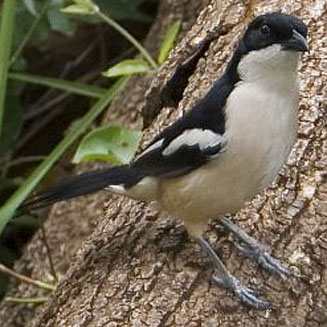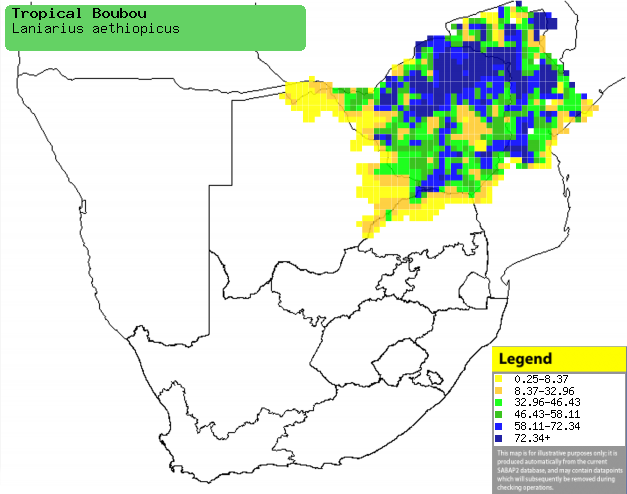|
Laniarius aethiopicus (Tropical
boubou)
Tropiese waterfiskaal [Afrikaans]; Nankuwo (generic
term for boubou) [Kwangali]; Ethiopische fiskaal [Dutch]; Gonolek d'Abyssinie
[French]; Orgelwürger, Tropischer flötenwürger [German]; Picanço-tropical
[Portuguese]
Life > Eukaryotes > Opisthokonta > Metazoa (animals) > Bilateria > Deuterostomia > Chordata > Craniata > Vertebrata (vertebrates) > Gnathostomata (jawed vertebrates) > Teleostomi (teleost fish) > Osteichthyes (bony fish) > Class: Sarcopterygii (lobe-finned fish) > Stegocephalia (terrestrial vertebrates) > Tetrapoda (four-legged vertebrates) > Reptiliomorpha > Amniota > Reptilia (reptiles) > Romeriida > Diapsida > Archosauromorpha > Archosauria > Dinosauria (dinosaurs) > Saurischia > Theropoda (bipedal predatory dinosaurs) > Coelurosauria > Maniraptora > Aves (birds) > Order: Passeriformes > Family: Malaconotidae
 |
|
|
Tropical boubou, Kruger National Park, South
Africa. [photo Trevor Hardaker ©] |
|
Distribution and habitat
Occurs from Liberia to East Africa south to southern
Africa, where it is locally common in Zimbabwe and northern Mozaabique extending
into Botswana and northern Limpopo Province. It often occupies habitats with
dense vegetation, such as montane forest, suburban gardens, thick coastal scrub,
savanna and miombo (Brachystegia) woodland, but in arid areas it is more
common in riverine scrub.
|
 |
|
Distribution of Tropical boubou in southern Africa,
based on statistical smoothing of the records from first SA Bird Atlas
Project (©
Animal Demography unit, University of
Cape Town; smoothing by Birgit Erni and Francesca Little). Colours range
from dark blue (most common) through to yellow (least common).
See here for the latest distribution
from the SABAP2. |
Brood parasites
It has been recorded as host of the
Black cuckoo.
Food
An adaptable hunter, it eats a variety of animals such as
rodents, insects and other birds. It often catches its prey off leaves and
branches then places them in a small tree fork, where it tears them apart with
its bill. It also exploits gatherings of insects in roadside drains or gutters,
especially after heavy rains. The following food items have been recorded in its
diet:
- Insects
- Snails
- Reptiles
- Amphibians
- Rodents
- Bird eggs and nestlings
Breeding
- The nest is a scruffy collection of twigs and rootlets, bound loosely
together with strands of spider web. It is usually placed in the fork of a
thorny branch, concealed by creepers and other vegetation. The female does
most of the nest construction, often starting to build multiple nests before
deciding on the optimal one to use that breeding season. The next year, the
same female salvages material from her previous nests, using them to
construct a string of a new ones.
- Egg-laying season is almost year-round, peaking from about
October-November.
- It lays 1-3 eggs, which are incubated mainly the female for roughly
14-16 days.
- During the first few days of their lives, the chicks are mainly fed
insects; the size of food items delivered to them increases as they get
older until eventually they eat bird nestlings and rodents. Although they
can fend for themselves a about 7 weeks old, they still remain dependent on
their parents for about 3.5 months more.
Threats
Not threatened.
References
-
Hockey PAR, Dean WRJ and Ryan PG 2005. Roberts
- Birds of southern Africa, VIIth ed. The Trustees of the John Voelcker
Bird Book Fund, Cape Town.
|
